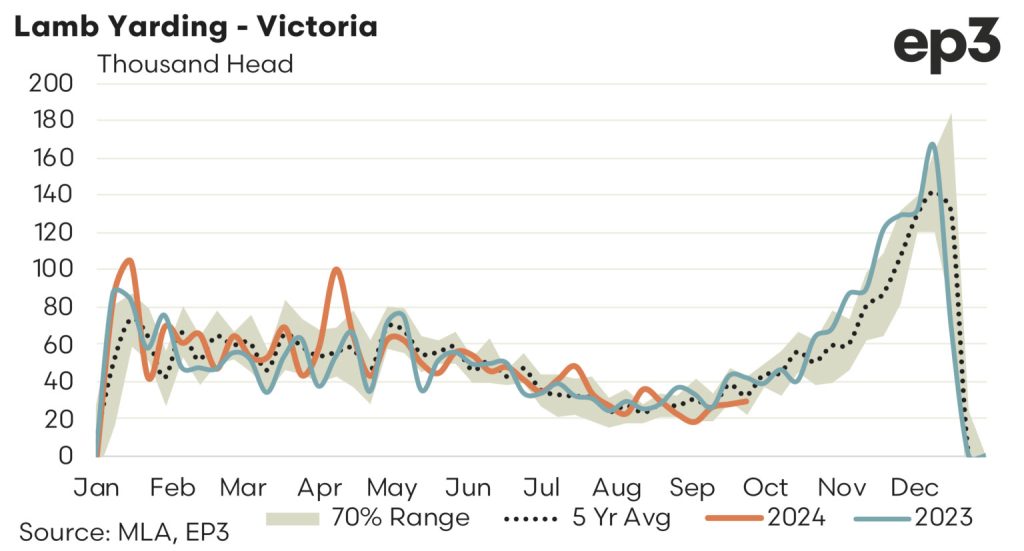Market Morsel
Throughout September weekly sheep slaughter volumes have been on a steady climb higher in several mainland states with east coast slaughter volumes for the last week of September hitting a seasonal record of 185,358 head processed. These volumes are nearly 50% stronger than the levels processed in the final week of September 2023 and quite uncharacteristic for this time in the season. Over the last five years average weekly sheep slaughter levels across the eastern seaboard sits close to 100,000 head so the sheep cull is very strong presently, particularly in South Australia and New South Wales.
The sheep slaughter index diagram displayed highlights how current slaughter levels, as measured by the average weekly slaughter volumes over the last month, compares to the historic weekly slaughter volumes within each state for the last five years. Think of each respective state column is a little bit like a rain gauge, but instead of measuring how many millimetres you have received overnight they are measuring how many sheep are being processed presently within each state relative to the recent volumes.

South Australian sheep slaughter volumes have an index score of 96%, which is the highest across all states. This signifies that average week sheep slaughter in SA during September was higher than 96% of all weekly sheep slaughter records over the last five years. Another way of looking at this score is that for the last five years only 4% of weekly sheep slaughter records in SA have been higher than the current volumes being processed.
A look across to the equivalent measure in SA lamb slaughter for the September period shows that there could be a bit of a substitution effect of lamb for sheep on the SA meat works processing floor as the SA lamb slaughter index is running at just 35% presently. A possible reflection of the fact that the spring flush of lambs in SA is yet to get into full swing and there are more purchasing opportunities for sheep over lamb at the moment.

Indeed, similar saleyard throughput index measurements in SA for lamb sits at 46% meanwhile the SA sheep saleyard throughput index is at 82% confirming that sheep supply is more robust than lamb supply in SA at the moment.
New South Wales is seeing similar strong sheep processing volumes with a slaughter index score of 85% and moderate levels of lamb slaughter with the NSW lamb slaughter index at 50% so the abattoir favouring of sheep over lamb doesn’t appear to be confined to SA alone.
Strong sheep slaughter levels isn’t just an east coast phenomena presently either. In WA the sheep slaughter index score sits at 91%, much stronger than the WA lamb slaughter score which has got a bit of the “stuck in the middle with you” vibe on just 46%.
Meanwhile, Victorian sheep slaughter is running at 80% and repeating the scenario played out by the other states outlined above with sheep processing volumes running well ahead of lamb processing volumes. The Victorian lamb slaughter index score sits at just 39%, which isn’t too bad considering the anecdotal reports from Victorian meat works that lamb supply is pretty thin on the ground at the moment.
Analysis of the Victorian saleyard throughput index confirms that the spring flush of lambs in Victoria is running behind the normal schedule. The Victorian lamb yarding index is currently 14%, indicating that the saleyard lamb numbers in Victoria during September are running at weekly levels that are 86% below all of the historic yarding records for the last five years.

Indeed, average weekly lamb yarding levels in Victoria during September was close to 25,000 head, which is about 10,000 head below what was presented at saleyards in Victoria during September last year and around 7,000 head below what you could expect to see each season in September, based on the last five years of throughput data. In percentage terms the current Victorian lamb supply at the saleyards is running nearly 22% below the usual levels you could expect to see at this time in the season.
The biggest outlier in terms of sheep slaughter index score across the country comes from Tasmania with a September measure of just 15%. Interestingly the lamb slaughter score in Tasmania is equally soft at the moment sitting at 19%. Suggesting that there is plenty of spare capacity in Tasmanian meat works at the moment for sheep and lamb.




